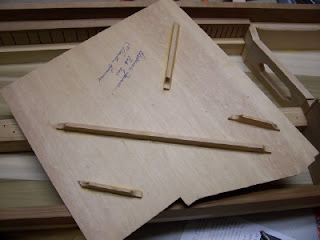Since the shellac needed to dissolve for at least 12 hours in denatured alcohol, I decided to skip ahead while the alcohol did its thing. Sooo....
Now comes the case molding. I don't use miter boxes on a daily basis, nor am I handy with a saw. But considering my very limited skills, I think I did a decent enough job. Here's an example of how my mitered corners came out using my fine-toothed Exacut saw.
I plan to fill the tiny little crack with some Famowood #1 Professional Wood Filler in red oak. I've filled larger gaps and you couldn't tell. In fact, I've repaired huge chunks and then filed and sanded the molding lines to match perfectly. This was, of course, on a painted surface, but when the paint went on, not a soul knew, and I sure wasn't telling. The holes left by the nails I used to hold the molding to the case while the glue dried will be steamed shut when I can grab some time.
Then came the "dressing" of the soundboard. That's fancy talk for wiping on the shellac. After a quick sanding with a super fine sanding sponge block, I took a piece of cheese cloth, dipped it in the shellac, and quickly wiped it on the soundboard. It just glided on.
I let it dry for over two hours and then drilled for the hitchpins, slanting the holes against the eventual pull of the strings. The manual warns to not make the slant too severe so as to pop through the side, so of course I had to do the first one exactly like that. Oops. All the others went without a "hitch." (That's a little clavichord humor.) I didn't find that job nearly as boring as drilling the tuning pin holes, but of course, the bit was 1/16", and something that small zips through the wood easily. And I don't believe I was drilling into oak, either!
Then it was back to the soundboard which was given a second light sanding and a second coat of shellac. Here's where the clavichord stands as of tonight.
























